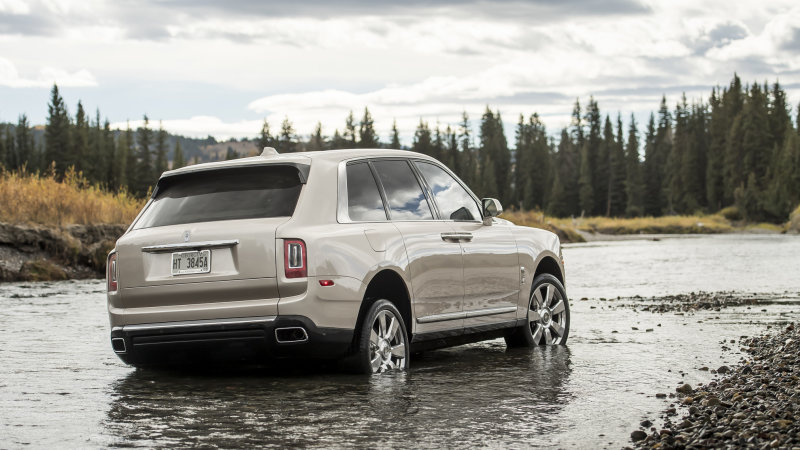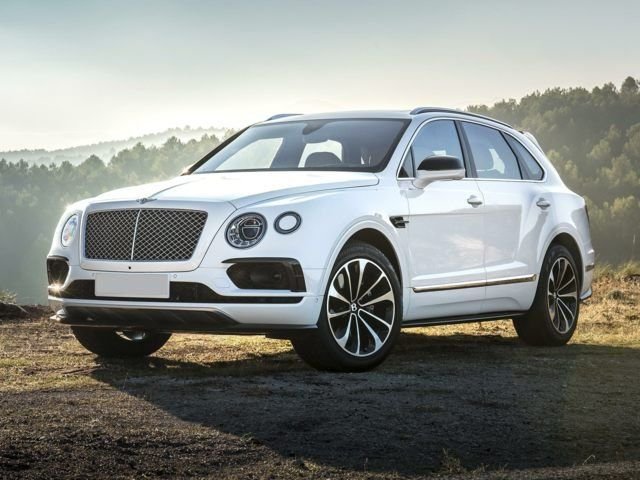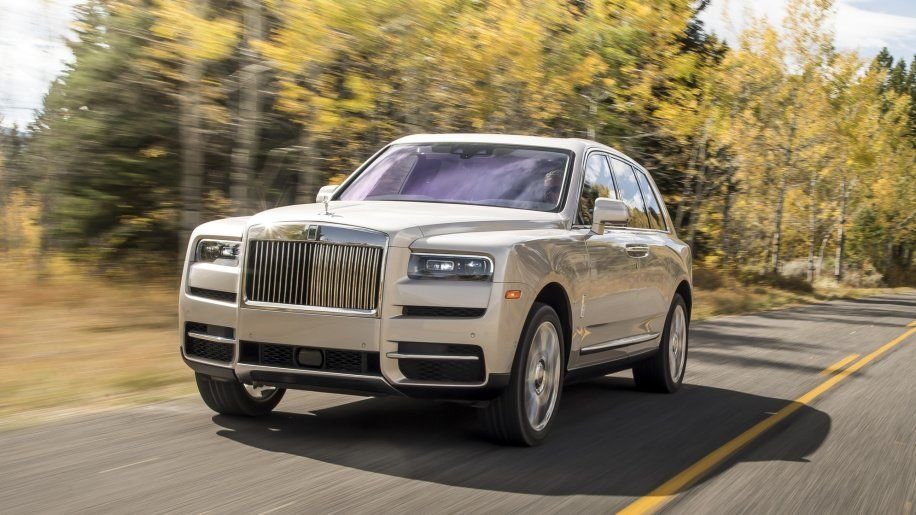Rolls Royce Cullinan SUV revealed .....
#31
Its on a new platform exclusive only to RR and will be shared with new Ghost/Dawn/Wraith etc.
Engines are also exclusive to RR.
I actually think the price is low considering a Phantom is around $500k.
This will sell like crazy and is much better execution than the Bentley SUV.
#32
Not sure about the chassis being exclusive, but the engine IS NOT. Its the same V12 used in the top line BMW 7 series, twin turbo, maybe a bit of a different tune for the Rolls Royce cars. Top end BMW's have proven to be unreliable, finicky garbage, I have no reason to doubt that the same thing will apply to this SUV once it ages out to about 5 to 7 years of use and racks up over 50,000 miles.
The engine is not on any BMW, its a 6.75L V12 currently used in the Phantom.
The platform/chassis was introduced on new Phantom and will be used for all RR cars including this Cullinan. The BMW M760 has a 6.6L V12.
Not sure which top end BMWs are unreliable?
There was a known issue with the N63 V8 which impacted small amount of cars. Please go on BMW forums and get info from actual owners.
Either way the last thing an RR owner cares about is long-term liability.
Last edited by RNM GS3; 05-15-18 at 03:42 AM.
#33
Not crazy about the design but i do like the little details like the double RR's in the headlamp units and the logo on the rear interior door panel leather.
It will be a nice wedding car in white of course for a bride/groom to ride around in for a daily rental price (which will probably be upwards of $1500 for a 3hr rental). That's the only reason I could imagine "average" folks getting into something like this...its an SUV for show.
It will be a nice wedding car in white of course for a bride/groom to ride around in for a daily rental price (which will probably be upwards of $1500 for a 3hr rental). That's the only reason I could imagine "average" folks getting into something like this...its an SUV for show.
#35
Car looks gorgeous. Im just upset that Rolls Royce decided to integrate the grill into the front bumper on their new cars like the ghost, the all new phantom and now the SUV. Really takes away from the classic look Rolls Royce is famous for. The large in your face separate grill in the front always looked nice. Now it appears to be integrated in the front bumper and I think it really takes away some of the that exclusive car charm. I prefer the grill on my silver shadow or silver spur.
#36
Hah yeah it's huge and tall. I saw one yesterday on the freeway. Ex NFL Larry Allen (700lb bench press guy) use to drive one (maybe still does). He'd drive it when coming to the theater I worked at in high school. Also had a green LX470.
It'd be cool if the upcoming royal wedding had some Cullinan's to wisk the royal family too and from.
#38
Before you spew hate and wrong info please do some research.
The engine is not on any BMW, its a 6.75L V12 currently used in the Phantom.
The platform/chassis was introduced on new Phantom and will be used for all RR cars including this Cullinan. The BMW M760 has a 6.6L V12.
Not sure which top end BMWs are unreliable?
There was a known issue with the N63 V8 which impacted small amount of cars. Please go on BMW forums and get info from actual owners.
Either way the last thing an RR owner cares about is long-term liability.
As for top spec BMW's being reliable, do a google search. Any of the 7 series are garbage reliability wise once they age out to about 5 to 10 years and more than 50-60k miles. Google that, its a fact, the BMW 7 series are money pits once they are out of warranty.
#39
The only way this car would work for me is if it was dimensionaly speaking much bigger than any other sedan in their line up. But, at least it looks better than the other ridiculous SUV's by the other luxury brands.
#40
Agreed, the formal, boxy lines of the newer Rolls Royce sedans work great on an SUV. If we tried doing 1950's Silver Cloud lines on a new SUV, it would look horrible.
#41

#42
Ease, isolation, and more than a bit of strong willed styling

JACKSON HOLE, Wyoming – The north face of Snow King Mountain drops a dizzying 1,571 feet, forming the steepest ski slope in the lower 48 states. Considering the Rolls-Royce Cullinan's prevailing theme of superlatives– it's named after the world's largest uncut diamond and claims the highest starting price of any SUV on the planet– it's no surprise that my first experience in the $325,000 monolith involved driving it up Snow King's switchback crisscrossed trail.
For a vehicle that proudly displays a retractable Spirit of Ecstasy ornament above the imposing "Parthenon" grille, there are a few subtle ways the Cullinan departs from Rolls-Royce's tried and true touchpoints. Though its platform is an expanded version of the Phantom VIII's new so-called Architecture of Luxury, the aluminum spaceframe houses Rolls-Royce's first-ever all-wheel drive powertrain. The twin-turbocharged 6.75-liter V12 is another familiar element that delivers 637 lb-ft of peak torque at an even lower 1,600 rpm; horsepower remains at 563, or as they once said in olden times, "sufficient." But unlike in Phantom and Ghost, the rear passengers aren't nestled behind the D-pillar like starlets in hiding but instead are exposed with a clear view of the surroundings thanks to considerable acreage of double-paned glass. The commanding visibility from the elevated seats is lovely, especially when approaching Snow King Mountain's initial ascent.
Though Cullinan is positioned as having some degree of offroad capability, don't expect the complex TerrainResponse settings you'll find in a run-of-the-mill Range Rover. The only drive mode setting is "Offroad," which elevates the air suspension, stiffens the ride (to avoid bottoming out the dampers), and ensures that wheels are pushed earthward if contact is lost. Throttle response is softened, and traction control becomes less restrictive and can be completely disabled.
For a vehicle that proudly displays a retractable Spirit of Ecstasy ornament above the imposing "Parthenon" grille, there are a few subtle ways the Cullinan departs from Rolls-Royce's tried and true touchpoints. Though its platform is an expanded version of the Phantom VIII's new so-called Architecture of Luxury, the aluminum spaceframe houses Rolls-Royce's first-ever all-wheel drive powertrain. The twin-turbocharged 6.75-liter V12 is another familiar element that delivers 637 lb-ft of peak torque at an even lower 1,600 rpm; horsepower remains at 563, or as they once said in olden times, "sufficient." But unlike in Phantom and Ghost, the rear passengers aren't nestled behind the D-pillar like starlets in hiding but instead are exposed with a clear view of the surroundings thanks to considerable acreage of double-paned glass. The commanding visibility from the elevated seats is lovely, especially when approaching Snow King Mountain's initial ascent.
Though Cullinan is positioned as having some degree of offroad capability, don't expect the complex TerrainResponse settings you'll find in a run-of-the-mill Range Rover. The only drive mode setting is "Offroad," which elevates the air suspension, stiffens the ride (to avoid bottoming out the dampers), and ensures that wheels are pushed earthward if contact is lost. Throttle response is softened, and traction control becomes less restrictive and can be completely disabled.

Cullinan feels large and commanding from the driver seat which makes tackling the steep grade seem all the more doable. Push the Offroad button and the vehicle lifts up in steps, like a camel getting on its feet. There's a notably softer pause between throttle input and forward motion when you're climbing loose gravel, so much so that you might need to bury the throttle to get going. What's actually happening beneath you, though, remains a bit of a mystery thanks to the surreal levels of isolation and sound deadening embedded into this platform. Rolls says they used 220 pounds of insulation to cosset the passengers in silence, and that seems spot on; even with the windows dropped, all I could hear was the crunch of tires over loose rocks as I eased forward. You'd think the car was coasting uphill by divine providence (or battery power).
Engineering boss Caroline Krismer reveals that traction is regained by individually braking wheels that slip, but again, I'd have to take her word for it; Cullinan just seems to glide up the mountain's scraggly surfaces, despite riding on 22-inch summer tires. Another disarming point about the uphill process: only twice during the ascent did the massive 'ute need to make a three-point turn around the tight hairpins thanks to the four-wheel steering system that virtually shrinks Cullinan's turning radius considerably.
I know what you're thinking: nobody's yee-hawing their Cullinan into some improbable offroad scenario in real life. Fair enough. Press the Offroad button again, and Cullinan settles downward, switches to standard mode, and feels immediately more responsive to throttle. Alertness is, of course, a relative term as this 6,069-pound behemoth takes every input in stride, responding with a rather calculated weight, counterweight, and action. Though it turns more easily at lower speeds than you might expect, it's more stately than nimble, more buttery smooth than overeager. The soft throttle tip in doesn't exactly beg for hard acceleration. However, when you lay into that right pedal Cullinan charges ahead quietly yet fiercely, sprinting (without seeming breathless) to 60 mph in a claimed 5 seconds flat. You wouldn't know the ZF-sourced 8-speed is shifting, it's so imperceptible. And the satellite linkage system that's shared with Phantom enables Cullinan to consider the bends in the road ahead when devising a shift strategy.
The eerie quiet of the offroading experience repeats itself during onroad driving, aided by foam inserts in the front wheels which help further dull droning low frequency sounds. Though some bumps and bobs in the road still feel perceptible, the prevailing mood in the cabin is one of extreme isolation, with the lack of distracting wind or road noise encouraging soft-spoken conversation (or a zen-like absence of it). There's still a hint of ambient noise from the road at higher speeds, which is supported by Krismer's acknowledgment that Phantom is incrementally quieter and therefore still the standard setter in the lineup. But Cullinan, especially at speed, is still a remarkably peaceful ride that offers its own distinct personality amidst the Rolls-Royce lineup.
Engineering boss Caroline Krismer reveals that traction is regained by individually braking wheels that slip, but again, I'd have to take her word for it; Cullinan just seems to glide up the mountain's scraggly surfaces, despite riding on 22-inch summer tires. Another disarming point about the uphill process: only twice during the ascent did the massive 'ute need to make a three-point turn around the tight hairpins thanks to the four-wheel steering system that virtually shrinks Cullinan's turning radius considerably.
I know what you're thinking: nobody's yee-hawing their Cullinan into some improbable offroad scenario in real life. Fair enough. Press the Offroad button again, and Cullinan settles downward, switches to standard mode, and feels immediately more responsive to throttle. Alertness is, of course, a relative term as this 6,069-pound behemoth takes every input in stride, responding with a rather calculated weight, counterweight, and action. Though it turns more easily at lower speeds than you might expect, it's more stately than nimble, more buttery smooth than overeager. The soft throttle tip in doesn't exactly beg for hard acceleration. However, when you lay into that right pedal Cullinan charges ahead quietly yet fiercely, sprinting (without seeming breathless) to 60 mph in a claimed 5 seconds flat. You wouldn't know the ZF-sourced 8-speed is shifting, it's so imperceptible. And the satellite linkage system that's shared with Phantom enables Cullinan to consider the bends in the road ahead when devising a shift strategy.
The eerie quiet of the offroading experience repeats itself during onroad driving, aided by foam inserts in the front wheels which help further dull droning low frequency sounds. Though some bumps and bobs in the road still feel perceptible, the prevailing mood in the cabin is one of extreme isolation, with the lack of distracting wind or road noise encouraging soft-spoken conversation (or a zen-like absence of it). There's still a hint of ambient noise from the road at higher speeds, which is supported by Krismer's acknowledgment that Phantom is incrementally quieter and therefore still the standard setter in the lineup. But Cullinan, especially at speed, is still a remarkably peaceful ride that offers its own distinct personality amidst the Rolls-Royce lineup.

There's even an available glass partition to isolate the cabin from the luggage area, and folding leather seats which deploy from the rear for tailgate parties. Sure, there are plenty of familiar RR cues like instrument layout and switchgear, but Cullinan incorporates those elements in a more vertical proportion from the IP to the low-silled windows, which have a way of making you feel less like you're tucked into cave and more like the world around you just became more accessible.
You'll want to carefully consider your entry speed into higher velocity corners since the center of gravity is relatively high, and there's perceptible body lean, despite the automatically adjusting stabilizer bars. Steering effort is supremely light, which has something to do with how easy it was to whip the Cullinan up the mountain and back down again with an autopilot-like hill descent control setup. But even on the road, there is such intuitive responsiveness to all controls that it becomes easy to drive Cullinan gracefully. In fact, among the reasons steel, not carbon ceramic brakes, was chosen is because the carbon stoppers would not have actuated as quietly or smoothly as the standard setup.
With the ultraluxury sport utility party in full swing thanks to the likes of Bentley and Lamborghini, Rolls-Royce's Cullinan isn't exactly an early bloomer. But there's still room for more in this rarified space, with Aston Martin and Ferrari promising entries into the high dollar sport 'ute market. Do they pose a real threat to the beast from Goodwood? Unlikely, mostly because Cullinan does precisely what Rolls-Royce has been doing for 112 years: producing quiet, luxurious rides that embody ease, isolation, and more than a bit of strong willed styling.
In fact, offroad capability isn't even a new concept for the brand, as colony dwellers and explorers in the 1920s chose Rolls-Royces for adventure travel since the British carmaker's offerings tended to be more robust than the next brand. That said, of course it's natural for most people to see no justifiable need for a Rolls-Royce Cullinan. But for the buyers who have lined up on a year-long waiting list, it seems the Cullinan couldn't have arrived sooner.
You'll want to carefully consider your entry speed into higher velocity corners since the center of gravity is relatively high, and there's perceptible body lean, despite the automatically adjusting stabilizer bars. Steering effort is supremely light, which has something to do with how easy it was to whip the Cullinan up the mountain and back down again with an autopilot-like hill descent control setup. But even on the road, there is such intuitive responsiveness to all controls that it becomes easy to drive Cullinan gracefully. In fact, among the reasons steel, not carbon ceramic brakes, was chosen is because the carbon stoppers would not have actuated as quietly or smoothly as the standard setup.
With the ultraluxury sport utility party in full swing thanks to the likes of Bentley and Lamborghini, Rolls-Royce's Cullinan isn't exactly an early bloomer. But there's still room for more in this rarified space, with Aston Martin and Ferrari promising entries into the high dollar sport 'ute market. Do they pose a real threat to the beast from Goodwood? Unlikely, mostly because Cullinan does precisely what Rolls-Royce has been doing for 112 years: producing quiet, luxurious rides that embody ease, isolation, and more than a bit of strong willed styling.
In fact, offroad capability isn't even a new concept for the brand, as colony dwellers and explorers in the 1920s chose Rolls-Royces for adventure travel since the British carmaker's offerings tended to be more robust than the next brand. That said, of course it's natural for most people to see no justifiable need for a Rolls-Royce Cullinan. But for the buyers who have lined up on a year-long waiting list, it seems the Cullinan couldn't have arrived sooner.







